How to fix a Haier AC160S2SK1FA that will not restart?
- VVincent DunnAug 3, 2025
If your Haier Air Conditioner won't restart after stopping, please wait 3 minutes before attempting to restart it.
How to fix a Haier AC160S2SK1FA that will not restart?
If your Haier Air Conditioner won't restart after stopping, please wait 3 minutes before attempting to restart it.
Why is the DC or AC voltage high in my Haier AC160S2SK1FA Air Conditioner?
The AC power supply of the driver module might be getting voltage over 280VAC or the driver module might be getting a high DC-BUS voltage over 390VDC. This issue is resumable.
What causes the indoor pipe temperature too high protection in my Haier Air Conditioner?
The indoor pipe temperature (Tm) might be over 63°C. The error will clear within 3 minutes if the temperature goes down and is lower than 52°C. This issue is resumable.
Why does my Haier AC160S2SK1FA show an indoor pipe sensor temperature too low protection?
Indoor pipe temperature might be too low. This causes the outdoor unit to stop to prevent indoor heat exchange system icing and to prevent the indoor unit outlet air from being too low. This issue is resumable.
Why is there no outlet air or why can't the fan speed be changed in dry mode on my Haier AC160S2SK1FA Air Conditioner?
The unit will reduce fan speed repeatedly and automatically if the room temperature is too low in dry operation.
Why won't the indoor fan stop in my Haier Air Conditioner, even after the unit is turned off in heating operation?
After the unit stops, the indoor fan will continue running until the indoor unit cools down.
Why is water or steam blown out of the outdoor unit of my Haier Air Conditioner during heating operation?
This occurs when frost accumulated on the outdoor unit is removed during defrosting operation.
Essential safety precautions for operation, storage, and handling of the air conditioner.
Details on product conformity with CE, ROHS, and WEEE European directives.
Instructions for correct disposal of electrical and electronic products and batteries.
Information on refrigerant type, GWP, and proper filling procedures for safe use.
Procedures for responsible disposal of old units and packaging materials.
Critical safety instructions covering operation, installation, and maintenance.
Cautions regarding ventilation, worker qualification, servicing, and hazard prevention.
Safety measures for electrical checks, repairs, cabling, and refrigerant handling.
Detailed procedures for refrigerant recovery, labelling, and safe handling.
Technical specifications, temperature ranges, and guidelines for unit movement and scrapping.
Precautions for safe installation, including room area, wiring, and grounding.
Specific warnings for installation, room area requirements, and connecting lines.
Safety guidelines for system transfer, repair, and general operation.
Comprehensive warnings covering electrical, operational, and environmental safety aspects.
Description of automatic operation for cooling and heat/cool types.
Explanation of the sleep mode feature for cooling and heating operations.
Information on the wireless remote control unit and mildew-resistant air filter.
Identification and description of parts for the indoor unit's control panels.
Explanation of the HOT KEEP function and heat pump warming operation.
Step-by-step instructions for cleaning the air filter.
Recommendations for regular inspection and cleaning of the indoor unit.
Explanation of normal sounds like water flow, cracking, and refrigerant noise.
Checks for power supply, circuit breakers, and basic operational settings.
Checks for air filter, louvers, sunlight, obstacles, and room conditions.
List of outdoor unit error codes, malfunction descriptions, and diagnosis for errors 1 through 18.
List of outdoor unit error codes, malfunction descriptions, and diagnosis for errors 19 through 45.
Important warnings and cautions regarding installation by dealers and environmental safety.
Guidelines and requirements for installation work performed by authorized service personnel.
Criteria and considerations for choosing the optimal mounting location for the unit.
List of optional parts and required maintenance space dimensions for installation.
Procedure for removing intake grill and side covers for indoor unit installation.
Steps for cutting the intake grill and installing the drain pipe correctly.
Instructions for installing drain and connecting pipes for ceiling and floor installations.
Guidelines for locating and drilling holes for ceiling suspension bolts.
Procedure for attaching suspension bolts with special nuts and anchor bolts.
Steps for mounting the indoor unit and insulating the coupler heat.
Requirements for drain hose installation, including gradient, material, and insulation.
Steps for connecting wiring to the indoor unit terminals.
Detailed methods for connecting solid core and strand wiring to terminal blocks.
Instructions for fixing power cables and connecting indoor and outdoor units.
Wiring diagrams and procedure for installing the fresh air intake.
Checklist for indoor and outdoor unit operations before customer handover.
Explanation of basic operations, filter cleaning, and manual handover to the customer.
Essential safety precautions for operation, storage, and handling of the air conditioner.
Details on product conformity with CE, ROHS, and WEEE European directives.
Instructions for correct disposal of electrical and electronic products and batteries.
Information on refrigerant type, GWP, and proper filling procedures for safe use.
Procedures for responsible disposal of old units and packaging materials.
Critical safety instructions covering operation, installation, and maintenance.
Cautions regarding ventilation, worker qualification, servicing, and hazard prevention.
Safety measures for electrical checks, repairs, cabling, and refrigerant handling.
Detailed procedures for refrigerant recovery, labelling, and safe handling.
Technical specifications, temperature ranges, and guidelines for unit movement and scrapping.
Precautions for safe installation, including room area, wiring, and grounding.
Specific warnings for installation, room area requirements, and connecting lines.
Safety guidelines for system transfer, repair, and general operation.
Comprehensive warnings covering electrical, operational, and environmental safety aspects.
Description of automatic operation for cooling and heat/cool types.
Explanation of the sleep mode feature for cooling and heating operations.
Information on the wireless remote control unit and mildew-resistant air filter.
Identification and description of parts for the indoor unit's control panels.
Explanation of the HOT KEEP function and heat pump warming operation.
Step-by-step instructions for cleaning the air filter.
Recommendations for regular inspection and cleaning of the indoor unit.
Explanation of normal sounds like water flow, cracking, and refrigerant noise.
Checks for power supply, circuit breakers, and basic operational settings.
Checks for air filter, louvers, sunlight, obstacles, and room conditions.
List of outdoor unit error codes, malfunction descriptions, and diagnosis for errors 1 through 18.
List of outdoor unit error codes, malfunction descriptions, and diagnosis for errors 19 through 45.
Important warnings and cautions regarding installation by dealers and environmental safety.
Guidelines and requirements for installation work performed by authorized service personnel.
Criteria and considerations for choosing the optimal mounting location for the unit.
List of optional parts and required maintenance space dimensions for installation.
Procedure for removing intake grill and side covers for indoor unit installation.
Steps for cutting the intake grill and installing the drain pipe correctly.
Instructions for installing drain and connecting pipes for ceiling and floor installations.
Guidelines for locating and drilling holes for ceiling suspension bolts.
Procedure for attaching suspension bolts with special nuts and anchor bolts.
Steps for mounting the indoor unit and insulating the coupler heat.
Requirements for drain hose installation, including gradient, material, and insulation.
Steps for connecting wiring to the indoor unit terminals.
Detailed methods for connecting solid core and strand wiring to terminal blocks.
Instructions for fixing power cables and connecting indoor and outdoor units.
Wiring diagrams and procedure for installing the fresh air intake.
Checklist for indoor and outdoor unit operations before customer handover.
Explanation of basic operations, filter cleaning, and manual handover to the customer.
| Inverter | Yes |
|---|---|
| Power Supply | 220-240V, 50Hz |
| Refrigerant | R32 |
| Type | Split System |
| Cooling Capacity | 16000 BTU/h |
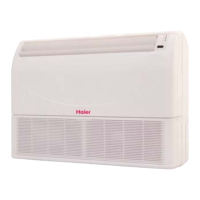
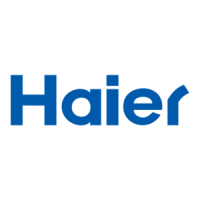
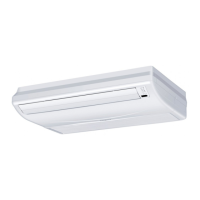






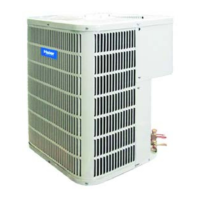
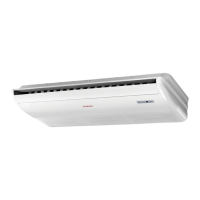

